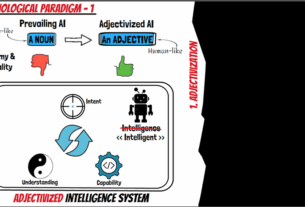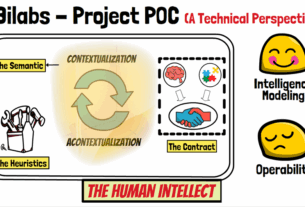Video Transcript:
The purpose of this video is to disambiguate some of the notions associated with previously introduced Acontextual Model of Cognition in the fifth of the 10-part whiteboard video series, in response to received feedback.
Firstly, the postulate clauses may not be looked at as capabilities of the resulting intelligence. These are more of ingredients to the recipe of cognition. As an analogy, the clauses relate more to sugar than sweetness. For example, the Innovation clause refers to the ability of the subject agency to incrementally diverge from the Contextualized coordinates within the systemic Semantic. This, in aggregation might result in an opinion, a joke or the idea behind Page algorithm depending on the object involved. On the other hand, a more radical divergence entailed by the Discovery clause might produce a revolutionary thought, a crass joke, or the Theory of Relativity.
A visual schematic of the human intellect dynamics as per the Acontextual Model of Cognition, in NLP domain follows. This portrays the process that’s going to run in your minds in a bit. Contextualization-Acontextualization cycles run on appropriately chunked object segments (in this case, the phrases) to synthesize semantic interpretations. Notice the continually morphing object fed to consecutive iterations of the run. That is the process of semantically consistent interpretations aggregating to generate an algorithm denoting the subjective cognition. For the purpose of explanation, the algorithm may be looked at as the subjective thought inspired by the object, though this is one of the said simplifications. Your individual understandings of the sentence are likely to fall within a common semantic neighborhood, with the implication that your neighbors can readily infer a finite transformational path between your respective algorithms. That is to say, your neighbors see your point, whether they agree with you or not. Such an instrumental capability, termed ‘Finite Persuadability’, provides the leverage to various other desired competencies such as an innate motivation for systemic communication, ability to reason with the agents, enhanced human-like learnability, and more. These capabilities evidently find an explanation in combining the right ingredients of Acontextual cognition.
The contexts and capabilities to appreciate, reason with, and learn from peer intelligences may also be seen in the hypothetical conversation between the synthetic agents as presented in the fourth video. When the Neophyte was presented with more system grounded interpretations, he not only understands but even finds them appealing. Also, more mature future responses likely from the agents due to their appreciation of alternate perspectives align with human way of learning than the machine learning as we know it.
Further, a better operational understanding to the agent-level attribute of being finitely persuadable within an intelligence system is in terms of the system-level feature termed the Algorithmic Fluidity. This relates to the ease with which the algorithms denoting agent cognition can consistently change their form and format. That’s saying, the ability to transmutate between any two consistent interpretations of an object within an intelligence system is a function of how fluid the systemic algorithms are. Implied granularity required of the constituents that make up the systemic algorithms offers an intuition to the notion of micro-algorithms. Also, the contractual bind necessary between the subject and the object driven by the system becomes apparent.
Acontextual model of cognition attempts to explain various subtleties of the human mind with layers of so portrayed runs resultant of alternate object segmentations, stacked along dimensions of freedom to the intelligence allowed by the subject-object contract. Further, semi-operational understanding to various capabilities such as imagination, analysis, strategy, wisdom, and more becomes possible with right orchestration of the components of Acontextual model of cognition.

Video 5.1 Summary
Simply speaking, Video #5.1(/10) introduces some finer details of the Acontextual Model of Cognition, which will be important later for defining a method.
- Cognition as a wholesome recipe: The postulates introduced in Video #5 of the Acontextual Model of Cognition are not standalone abilities of intelligence, but rather ingredients in the recipe that makes cognition possible. Moreover, their names should not be taken at face value; for example, the ‘common sense’ clause refers not to everyday reasoning, but to the shared or common way of sensing and interpreting a given object by peer agencies, which is the focus of this video.
- One for all and all for one: The individual clauses work together in intricate ways. Returning to the recipe analogy, just as leaving out one ingredient might change the entire dish, human cognition arises necessarily through the full blend of all these postulates. Each clause connects with the others, gaining its relevance from them while also giving them meaning in return.
- Why communication works: According to the model, meaning is created through alternating cycles of Contextualization and Acontextualization. For this meaning to be meaningful, one Omnijective criterion is its communicability. This has nothing to do with the language proficiency of the agency involved, but rather with the meaning itself. It further requires that the meanings built by two peer agencies remain within a shared semantic neighborhood, where each can be morphed into the other through a finite number of transformations. This property, called Finite Persuadability, is what allows me to see your point and you to see mine – in an otherwise siloed existence of incompatible intelligences.
- How communication works: Producing finitely persuadable meaning is a defining trait of the human mind. Simulating this attribute in synthetic systems requires finely grained algorithmic constituents – the finer, the better. This systemic property, known as Algorithmic Fluidity, gives rise to semantic segmentations such as micro-algorithms. The vast potential of this consideration in shaping an operational method will be further explored in Video 7 subseries.
- Countless modes, one cognition: Each clause of the Acontextual Model of Cognition is not only necessary but, taken together, sufficient to account for the full spectrum of human cognitive nuances – analytical, emotional, attitudinal, social, metacognitive, and beyond.


